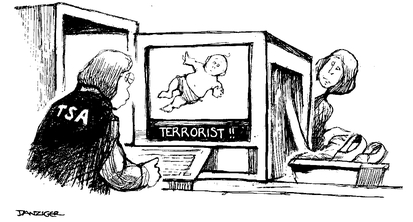CHAPTER 36
Probability and the War on Terror
A story in
USA Today describes how Christine Anderson first learned that her son was a suspected terrorist.
1 It was at the Minneapolis-St. Paul International Airport in 2004. “We checked in at the ticket counter, and the woman said in a stern voice, ‘Who is John Anderson?’ ” Christine pointed to her baby carriage.
To this day, young Mr. Anderson, along with 15,000 other U.S. travelers, have been unable to clear their names. John’s family cannot print out his boarding passes over the Internet but must show up in person at the ticket counter to prove that he is a child. This trademark issue in the War on Terror is known as the problem of false positives, and, as we will see, it often defies intuition.
Portions of this chapter appeared in Sam Savage and Howard Wainer, “Until Proved Guilty: False Positives and the War on Terror,” Chance Magazine, Vol. 21, No. 1 (2008).
The Magic Bullet
So how many true terrorists do you think are currently in the United States? I’m not talking about common thugs, cutthroats, or murderers, but hard-core professionals intent on mass murder. I have no idea myself, but for the sake of argument, suppose there are 3,000. That is, in the total U.S. population of 300 million, one person in 100,000 is the real deal.
Now consider a magic bullet for this threat: unlimited wire-tapping tied to advanced voice analysis ...


